A) the jobs argument
B) the national-security argument
C) the infant-industry argument
D) the efficiency argument
F) All of the above
Correct Answer

verified
Correct Answer
verified
Multiple Choice
Figure 9-15 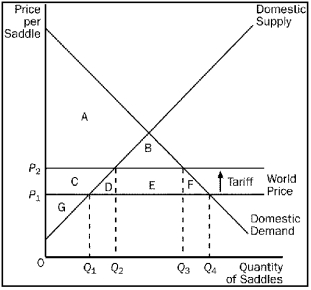 -Refer to Figure 9-15.Consumer surplus with trade and without a tariff is
-Refer to Figure 9-15.Consumer surplus with trade and without a tariff is
A) A.
B) A + B.
C) A + C + G.
D) A + B + C + D + E + F.
F) A) and D)
Correct Answer

verified
Correct Answer
verified
Multiple Choice
For any country that allows free trade,
A) domestic quantity demanded is equal to domestic quantity supplied at the world price.
B) domestic quantity demanded is greater than domestic quantity supplied at the world price.
C) both producers and consumers in that country gain when domestic products are exported,but both groups lose when foreign products are imported.
D) the domestic price is equal to the world price.
F) B) and D)
Correct Answer

verified
Correct Answer
verified
Multiple Choice
Some time ago,the nation of Republica opened up its paper market to international trade.Which of the following results of this policy change is consistent with the notion that Republica has a comparative advantage over other countries in producing paper?
A) The price of paper in Republica decreased as a result of the policy change.
B) Republica began exporting paper as a result of the policy change.
C) The domestic demand curve for paper shifted to the right as a result of the policy change.
D) The domestic quantity of paper demanded increased as a result of the policy change.
F) A) and C)
Correct Answer

verified
Correct Answer
verified
Multiple Choice
Scenario 9-1 The before-trade domestic price of tomatoes in the United States is $500 per ton.The world price of tomatoes is $600 per ton.The U.S.is a price-taker in the market for tomatoes. -Refer to Scenario 9-1.If trade in tomatoes is allowed,the United States
A) will become an importer of tomatoes.
B) will become an exporter of tomatoes.
C) may become either an importer or an exporter of tomatoes,but this cannot be determined.
D) will experience increases in both consumer surplus and producer surplus.
F) A) and D)
Correct Answer

verified
Correct Answer
verified
Multiple Choice
With which of the Ten Principles of Economics is the study of international trade most closely connected?
A) People face tradeoffs.
B) Trade can make everyone better off.
C) Governments can sometimes improve market outcomes.
D) Prices rise when the government prints too much money.
F) All of the above
Correct Answer

verified
Correct Answer
verified
True/False
Import quotas and tariffs both cause the quantity of imports to fall.
B) False
Correct Answer

verified
Correct Answer
verified
Multiple Choice
Figure 9-17 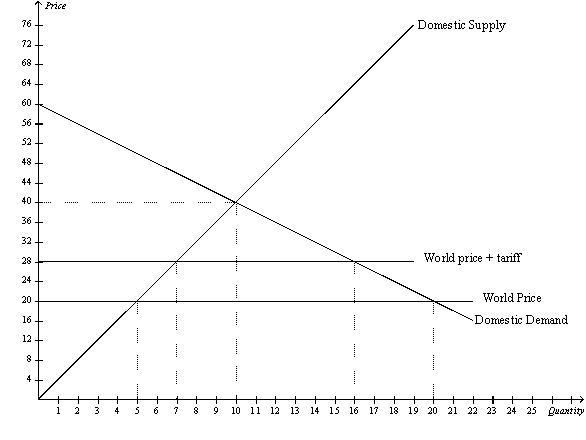 -Refer to Figure 9-17.With trade and a tariff,consumer surplus is
-Refer to Figure 9-17.With trade and a tariff,consumer surplus is
A) $202 and producer surplus is $50.
B) $202 and producer surplus is $98.
C) $256 and producer surplus is $50.
D) $256 and producer surplus is $98.
F) None of the above
Correct Answer

verified
Correct Answer
verified
True/False
Domestic consumers gain and domestic producers lose when the government imposes a tariff on imports.
B) False
Correct Answer

verified
Correct Answer
verified
Multiple Choice
When a country allows trade and becomes an importer of a good,
A) consumer surplus and producer surplus both increase.
B) consumer surplus and producer surplus both decrease.
C) consumer surplus increases and producer surplus decreases.
D) consumer surplus decreases and producer surplus increases.
F) All of the above
Correct Answer

verified
Correct Answer
verified
Multiple Choice
Figure 9-11 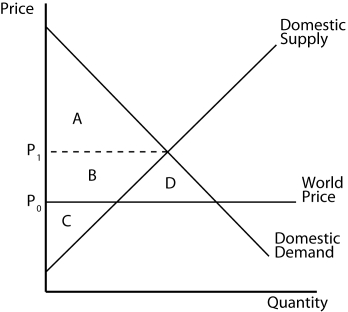 -Refer to Figure 9-11.Producer surplus plus consumer surplus in this market before trade is
-Refer to Figure 9-11.Producer surplus plus consumer surplus in this market before trade is
A) A + B.
B) A + B + C.
C) A + B + C + D.
D) B + C + D.
F) All of the above
Correct Answer

verified
Correct Answer
verified
Multiple Choice
Figure 9-6 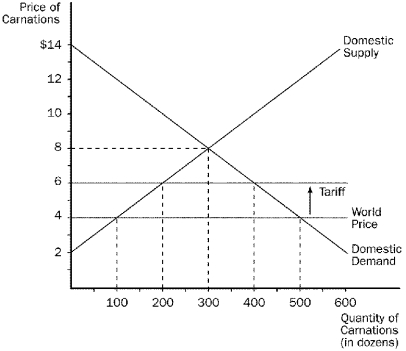 -Refer to Figure 9-6.The amount of deadweight loss caused by the tariff equals
-Refer to Figure 9-6.The amount of deadweight loss caused by the tariff equals
A) $100.
B) $200.
C) $400.
D) $500.
F) A) and D)
Correct Answer

verified
Correct Answer
verified
Multiple Choice
When a country allows international trade and becomes an importer of a good,
A) domestic producers of the good become better off.
B) domestic consumers of the good become worse off.
C) the gains of the winners exceed the losses of the losers.
D) All of the above are correct.
F) A) and C)
Correct Answer

verified
Correct Answer
verified
Multiple Choice
When a country that imports a particular good imposes an import quota on that good,
A) producer surplus increases and total surplus increases in the market for that good.
B) producer surplus increases and total surplus decreases in the market for that good.
C) producer surplus decreases and total surplus increases in the market for that good.
D) producer surplus decreases and total surplus decreases in the market for that good.
F) A) and D)
Correct Answer

verified
Correct Answer
verified
Multiple Choice
Figure 9-14.On the diagram below,Q represents the quantity of computers and P represents the price of computers. 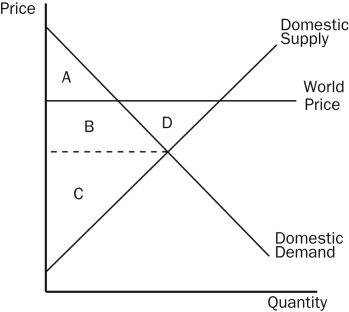 -Refer to Figure 9-14.A result of this country allowing international trade in computers is as follows:
-Refer to Figure 9-14.A result of this country allowing international trade in computers is as follows:
A) The well-being of domestic computer producers is now higher in that they now sell more computers at a higher price per computer.
B) The effect on the well-being of domestic computer consumers is unclear in that they now buy more computers,but at a higher price per computer.
C) The effect on the well-being of the country is unclear in that domestic producer surplus increases,while the effect on domestic consumer surplus is unclear.
D) All of the above are correct.
F) A) and B)
Correct Answer

verified
Correct Answer
verified
Multiple Choice
Figure 9-6  -The before-trade price of fish in Germany is $8.00 per pound.The world price of fish is $6.00 per pound.Germany is a price-taker in the fish market.If Germany allows trade in fish,then Germany will become an
-The before-trade price of fish in Germany is $8.00 per pound.The world price of fish is $6.00 per pound.Germany is a price-taker in the fish market.If Germany allows trade in fish,then Germany will become an
A) importer of fish and the price of fish in Germany will be $6.00.
B) importer of fish and the price of fish in Germany will be $8.00.
C) exporter of fish and the price of fish in Germany will be $6.00.
D) exporter of fish and the price of fish in Germany will be $8.00.
F) B) and C)
Correct Answer

verified
Correct Answer
verified
Multiple Choice
When a country abandons a no-trade policy,adopts a free-trade policy,and becomes an importer of a particular good,
A) producer surplus increases and total surplus increases in the market for that good.
B) producer surplus increases and total surplus decreases in the market for that good.
C) producer surplus decreases and total surplus increases in the market for that good.
D) producer surplus decreases and total surplus decreases in the market for that good.
F) A) and B)
Correct Answer

verified
Correct Answer
verified
Multiple Choice
Some goods can be produced at low cost only if they are produced in large quantities.This phenomenon is called
A) marginal cost of production.
B) marginal benefit of size.
C) economies of scale.
D) economies of production.
F) A) and C)
Correct Answer

verified
Correct Answer
verified
Multiple Choice
Figure 9-1
The figure illustrates the market for wool in New Zealand. 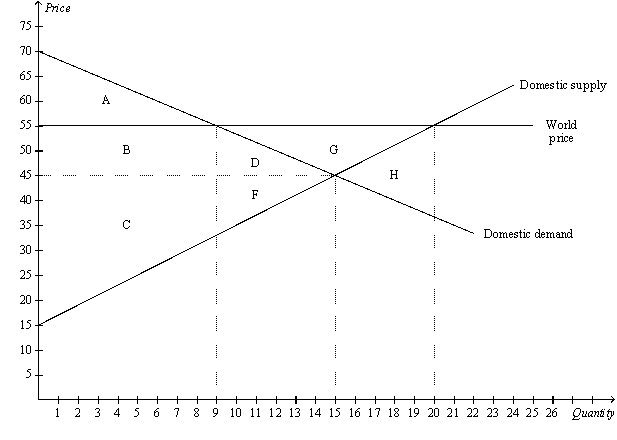 -Refer to Figure 9-1.In the absence of trade,the equilibrium price of wool in New Zealand is
-Refer to Figure 9-1.In the absence of trade,the equilibrium price of wool in New Zealand is
A) $15.
B) $45.
C) $55.
D) $70.
F) A) and C)
Correct Answer

verified
Correct Answer
verified
Multiple Choice
Figure 9-13 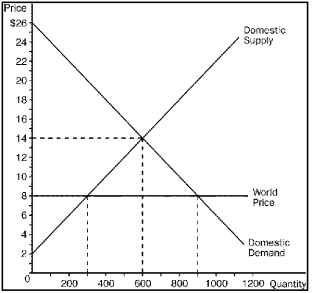 -Refer to Figure 9-13.The price and domestic quantity demanded after trade are
-Refer to Figure 9-13.The price and domestic quantity demanded after trade are
A) $8 and 300.
B) $8 and 900.
C) $14 and 900.
D) $14 and 600.
F) None of the above
Correct Answer

verified
Correct Answer
verified
Showing 161 - 180 of 333
Related Exams